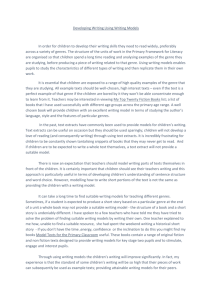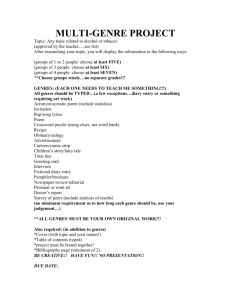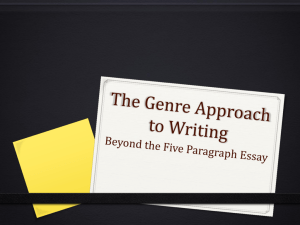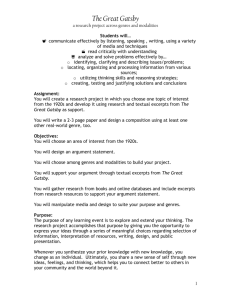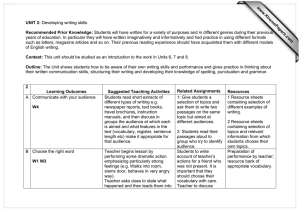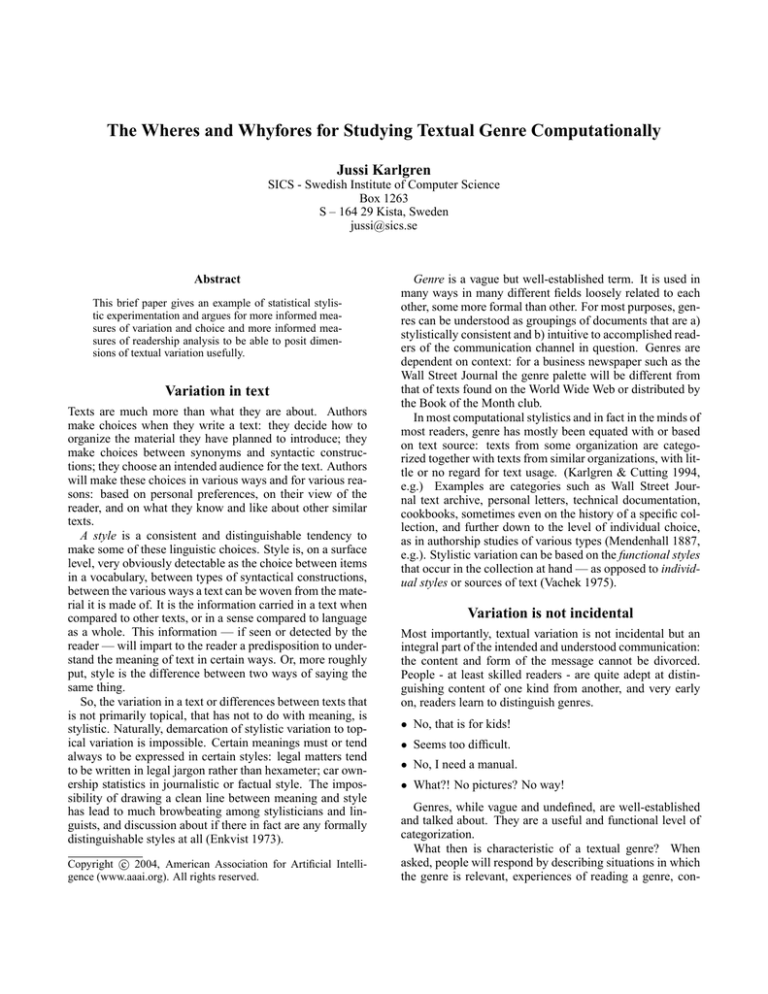
The Wheres and Whyfores for Studying Textual Genre Computationally
Jussi Karlgren
SICS - Swedish Institute of Computer Science
Box 1263
S – 164 29 Kista, Sweden
jussi@sics.se
Abstract
This brief paper gives an example of statistical stylistic experimentation and argues for more informed measures of variation and choice and more informed measures of readership analysis to be able to posit dimensions of textual variation usefully.
Variation in text
Texts are much more than what they are about. Authors
make choices when they write a text: they decide how to
organize the material they have planned to introduce; they
make choices between synonyms and syntactic constructions; they choose an intended audience for the text. Authors
will make these choices in various ways and for various reasons: based on personal preferences, on their view of the
reader, and on what they know and like about other similar
texts.
A style is a consistent and distinguishable tendency to
make some of these linguistic choices. Style is, on a surface
level, very obviously detectable as the choice between items
in a vocabulary, between types of syntactical constructions,
between the various ways a text can be woven from the material it is made of. It is the information carried in a text when
compared to other texts, or in a sense compared to language
as a whole. This information — if seen or detected by the
reader — will impart to the reader a predisposition to understand the meaning of text in certain ways. Or, more roughly
put, style is the difference between two ways of saying the
same thing.
So, the variation in a text or differences between texts that
is not primarily topical, that has not to do with meaning, is
stylistic. Naturally, demarcation of stylistic variation to topical variation is impossible. Certain meanings must or tend
always to be expressed in certain styles: legal matters tend
to be written in legal jargon rather than hexameter; car ownership statistics in journalistic or factual style. The impossibility of drawing a clean line between meaning and style
has lead to much browbeating among stylisticians and linguists, and discussion about if there in fact are any formally
distinguishable styles at all (Enkvist 1973).
c 2004, American Association for Artificial IntelliCopyright gence (www.aaai.org). All rights reserved.
Genre is a vague but well-established term. It is used in
many ways in many different fields loosely related to each
other, some more formal than other. For most purposes, genres can be understood as groupings of documents that are a)
stylistically consistent and b) intuitive to accomplished readers of the communication channel in question. Genres are
dependent on context: for a business newspaper such as the
Wall Street Journal the genre palette will be different from
that of texts found on the World Wide Web or distributed by
the Book of the Month club.
In most computational stylistics and in fact in the minds of
most readers, genre has mostly been equated with or based
on text source: texts from some organization are categorized together with texts from similar organizations, with little or no regard for text usage. (Karlgren & Cutting 1994,
e.g.) Examples are categories such as Wall Street Journal text archive, personal letters, technical documentation,
cookbooks, sometimes even on the history of a specific collection, and further down to the level of individual choice,
as in authorship studies of various types (Mendenhall 1887,
e.g.). Stylistic variation can be based on the functional styles
that occur in the collection at hand — as opposed to individual styles or sources of text (Vachek 1975).
Variation is not incidental
Most importantly, textual variation is not incidental but an
integral part of the intended and understood communication:
the content and form of the message cannot be divorced.
People - at least skilled readers - are quite adept at distinguishing content of one kind from another, and very early
on, readers learn to distinguish genres.
• No, that is for kids!
• Seems too difficult.
• No, I need a manual.
• What?! No pictures? No way!
Genres, while vague and undefined, are well-established
and talked about. They are a useful and functional level of
categorization.
What then is characteristic of a textual genre? When
asked, people will respond by describing situations in which
the genre is relevant, experiences of reading a genre, con-
tent, and in some cases specific lexical or other linguistic
features of the text.
Concrete example: Newsprint and its
subgenres
Newsprint, while a special register of human language use
in itself, is composed of several well-established subgenres.
While newsprint is – together with scientific and intellectual
text – over-represented as an object of empirical philological study as compared to other forms of human linguistic
communication, it possesses some quite useful qualities for
systematical study of linguistic characteristics, chief among
them that the texts are most often intended to be the way they
are. The textual material has passed through many hands on
its way to the reader in order to best conform to audience
expectations; individual variation – worth study in itself –
is not preserved to any appreciable extent in most cases; the
audience is well trained in the genre. In short, the path is
well-trod and as such easy to study. Newsprint may sound
to be a homogenous mass of text, but it contains several
well-established subgenres. In the present study one year
of Glasgow Herald is being studied, and many of the texts
are tagged for “ARTICLETYPE” – cf Table 1.
<ARTICLETYPE>
tagged
advertising
book
correspondence
feature
leader
obituary
profile
review
untagged
total
n
17467
522
585
3659
8867
681
420
854
1879
39005
56472
Figure 1: Sub-genres of the Glasgow Herald.
Observed differences between genres
It is easy enough to establish that there are observable differences between the genres we find posited in the textual material. Trawling the (morphologically normalized) texts for
differences, comparing each identified category in Table 1
with the other categories we find for a one month sample of
text some of the most typical words for each category as per
Table 2. “Typical” is here operationalized as words with a
document frequency deviating from expected occurrence as
assessed by χ2 . This sort of analysis can be entertaining, at
times revealing, but cannot really give us any great explanatory power. Even the handful of example terms shown in
Table 2 are clearly colored by the subject matter of the subgenres and only to some extent reveal any stylistic difference
between them.
<ARTICLETYPE>
advertising
book review
correspondence
feature
leader
obituary
profile
review
Typical words
provide, available, service,
specialist, business
novel, prose, author,
literary, biography, write
(Various locations in Scotland),
overdue, SNP
say, get, think, put, there,
problem, tell
evident, government, outcome,
opinion, even
church, wife, daughter,
survive, former
recall, career, experience,
musician
concert, guitar, piece,
beautifully, memorable
Figure 2: Typical words in sub-genres of one month of the
Glasgow Herald.
What are readers aware of?
Starting from first principles, a better approach may be to
ask people what they are aware of as differences between
newsprint genres. In questionnaires or interviews, readers
typically respond by answering in terms of utility of the
genre rather than text characteristics, in terms of perceived
quality of the text in some prescriptive terms, or in terms
of complexity of the text and subject matter. On follow-up
questioning readers will bring up subjective qualities such as
trustworthiness of the text or further discuss readability or
other specifics related to complexity, both lexical and syntactic (and specifically making claims in both dimensions,
typically claiming that leader articles are difficult and longwinded or that sports features are inane and simplistics).
These perceptions, again, may be interesting, elucidating,
and entertaining to discuss, but are difficult to encode and
put to practical use. While we as readers are good at the
task of distinguishing genres, we have not been intellectually trained to do so and we have a lack of meta-level understanding of how we proceed in the task. We need to
model human processing at least on a behavioural level at
least to some extent. We need to be able to address the data
on levels of usefulness, and we need to observe people using documents and textual information to understand what
is going on. Clustering data without anchoring information
in use will risk finding statistically stable categories of data
without explanatory power or utility.
Assumed differences between genres
A more linguistically informed approach is to start from established knowledge (or established presumption, as it were)
and to work with a priori hypotheses on qualities of textual
variation. This proves to be rather unproblematic. We know
from past studies and judicious introspection that interview
articles contain quotes and that leader articles contain argumentation; both are to be expected to contain pronouns and
overt expressions of opinion. Table 3 shows some such measurements – with indicated significance (better than 95%)
assessed for each sub-genre compared to the entire collection by Mann-Whitney U. The explanatory power of this table – again, while interesting in some respects and worth
discussion – is rather low, and application of the findings for
prediction of genre for unseen cases will be unreliable. A
more abstract level of representation is necessary to be able
to extract useful predictions and to gain understanding of
what textual variation is about.
<ARTICLETYPE>
p
dem
advertising
book review
correspondence
feature
leader
obituary
profile
review
+
+
+
-
.
+
+
+
+
-
+
.
p
dem
s&t
op arg
cpw
say &
think
+
+
+
.
.
+
-
op & arg
arg
.
+
+
+
+
-
cpw
+
+
+
+
Significantly higher values
Significantly lower values
Non-significant value distribution
Personal pronouns
Demonstratives: “that” &c.
Verbs of utterance and “Private” verbs1
Opinion2 and argument3
Characters per word
Figure 3: Some measurements of linguistic items per subgenre of one year of the Glasgow Herald.
Dimensions of variation
The above discussion gives purchase to the following
claims:
• Readers are aware of genres;
• Writers and editors are aware of genres;
• Genres are to some extent arbitrary and most decidedly
not independent of subject matter;
• Readers are not aware of most of what formal differences
there are between genres;
• It is easy to find and measure formal differences between
genres in terms of observable linguistic items;
• These measurements are not very interesting nor immediately useful.
Several authors have posited underlying dimensions of
variation within the space of textual variation, where genres
can be found as regions in terms of such dimensions – Involved vs Informed, Narration vs Argumentation, Personal
vs Impersonal etc. To study such underlying dimensions
of variation is the main object of study for computational
stylistics today, and a worthwhile goal – a goal which can
be accomplished at least to some extent using purely formal
methods, without studying text or readership.
But the ingoing measurements have hitherto been hampered by lack of useful tools. Even now, most measurements made in the literature are purely lexical or only locally syntactical. This form of study needs better tools for
measuring textual variation on the levels authors and readers
are processing information, not on the level of whitespace
separated character strings. Only if useful target measures
of pertinence, relevance, and utility can be found for evaluation, couched in terms derived from study of readership,
and if real measures of variation and choice, couched in informed terms of linguistic analysis rather than processing
convenience, can we hope to accomplish anything of lasting value in terms of understanding choice, textual variation,
and reading.
References
Enkvist, N. E. 1973. Linguistic Stylistics. The Hague,
Netherlands: Mouton.
Karlgren, J., and Cutting, D. 1994. Recognizing text genres with simple metrics using discriminant analysis. In Proceedings of the 15th International Conference on Computational Linguistics, volume 2, 1071–1075. Kyoto, Japan:
ICCL.
Mendenhall, T. 1887. The characteristic curves of composition. Science 9:237–249.
Quirk, R.; Greenbaum, S.; Leech, G.; and Svartvik, J.
1985. A comprehensive grammar of the English language.
London, England: Longman.
Vachek, J. 1975. Some remarks on functional dialects of
standard languages. In Ringbom, H., ed., Style and Text —
Studies presented to Nils Erik Enkvist. Stockholm, Sweden:
Skriptor.


